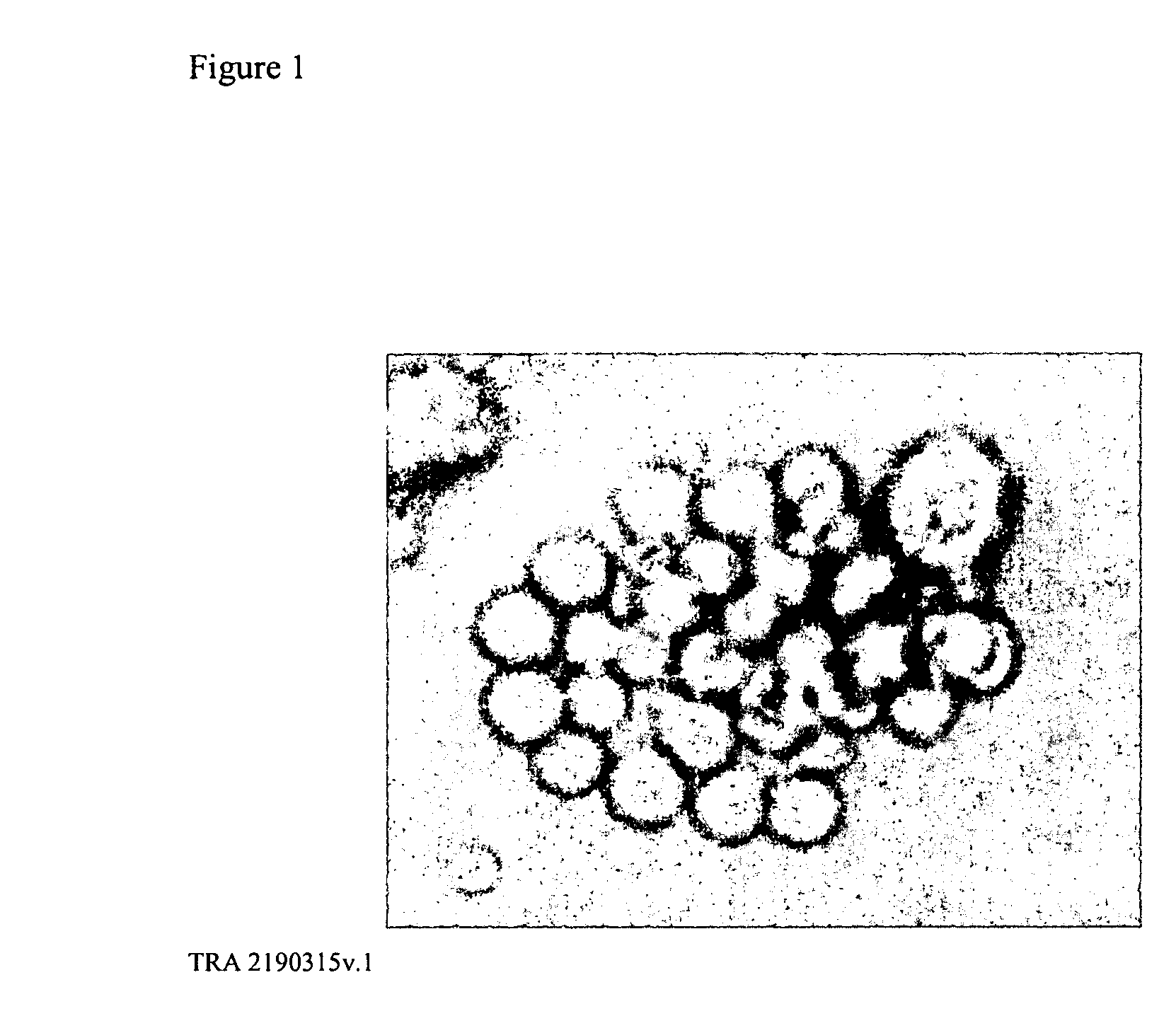Methods of producing stable B-lymphocytes
a technology of b-lymphocytes and stable cells, applied in the field of improving the survival and stability of cells, can solve the problems of unstable hybridoma generation, inefficient method, and loss of a large number of cells
- Summary
- Abstract
- Description
- Claims
- Application Information
AI Technical Summary
Benefits of technology
Problems solved by technology
Method used
Image
Examples
example 1
General Methods
[0073] Reagents
[0074] Culture medium DMEM / HAM's F12 (Cambrex Biosciences 12-719F) is prepared with 1300 mg / l sodium bicarbonate (Merck), 55 mg / l sodium pyruvate (Fluka), 2.3 mg / l 2-mercaptoethanol (Merck). 60 mg / l Gentamycin (Sigma), and 8% Fetal Bovine Serum (Wisent). In fusion experiments, the medium is further supplemented with 13.61 mg / l hypoxanthine (Fluka) and 3.83 mg / l thymidine (Fluka). This medium is referred to as DMEM / HAM's F12 / HT.
[0075] Selection of hybridomas is performed in DMEM / HAM's F12 / HT supplemented with 0.0004 mM aminopterin (Sigma) and optionally 1% of IL-6 containing supernatant of a human bladder carcinoma cell line T24 (T24CM). The selection medium is referred to as HAT-medium. Fusion medium: Ready to use hypo-osmotic buffer (Eppendorf AG)
[0076] Cell Cultures
[0077] Mutant EL-4 thymoma cells, EL-4 / B5 are routinely cultured in DMEM / HAM's F12 supplemented with 8% FCS) at cell concentrations between 1×104 to 1×106 c / ml. If the cells exceed a d...
example 2
EBV Transformation of Enriched Human B-Cells Isolated From an Anthrax-Vaccinated Donor Results in the Generation of a Stable B-Cell Culture Specific for Protective Antigen (PA)
[0105] Enriched B-cells from an Anthrax vaccinated donor were used to produce a stable B-cell culture producing monoclonal antibodies for Protective Antigen. In four independent experimental protocols as outlined below enriched B-cell isolated were seeded on 24 well plates with 3T6.CD40L cells. [0106] Protocol 1: Cells (5,000-10,000) were cultured on 100,000 3T6.CD40L cells / well in a 24 wells plate. Cells were EBV transformed immediately, by incubating with an adequate EBV stock. The EBV supernatant was replaced by standard growth medium plus IL-4 (10 ng / mL) after 2.5 hours. The B-cells were cultured in this medium for 2 to 3 weeks. [0107] Protocol 2: Cells (5,000-10,000) were cultured on 100,000 3T6.CD40L cells / well in a 24 wells plate and expanded for 3 days before EBV transformation. The EBV supernatant wa...
example 3
Handpicking of Fused Enriched Human B-cells Isolated from Anthrax Vaccinated Donor Results in of Production Antigen Specific Stable B-Cell Cultures
[0114] Enriched B-cells from an Anthrax vaccinated donor were panned as described above in a 6 wells plate coated with the desired antigen (Ag) Unbound cells were washed away and discarded, bound cells were removed from the plate by trypsin treatment (Protocol 1) or were left on the plate (Protocol 2). [0115] Protocol 1. Trypsin treated cells (1,000-1,500 cell per well) were added to 96-wells microtiter plates having 10,000 3T6.CD40L cells / well and IL4 (10 ng / mL). After 3 days of expansion, the wells were tested for anti-Ag antibody production. Cells from wells scoring positive for antibody were fused to K6H6 / B5 myeloma cells in a 1:1 ratio. Fusion either occurred by electrofusion or PEG fusion as described above). After the fusion, the fusion products are seeded into microtiter plates in a density of 10,000-20,000 cells / well and left in...
PUM
| Property | Measurement | Unit |
|---|---|---|
| diameter | aaaaa | aaaaa |
| volume | aaaaa | aaaaa |
| humidity | aaaaa | aaaaa |
Abstract
Description
Claims
Application Information
 Login to View More
Login to View More - R&D
- Intellectual Property
- Life Sciences
- Materials
- Tech Scout
- Unparalleled Data Quality
- Higher Quality Content
- 60% Fewer Hallucinations
Browse by: Latest US Patents, China's latest patents, Technical Efficacy Thesaurus, Application Domain, Technology Topic, Popular Technical Reports.
© 2025 PatSnap. All rights reserved.Legal|Privacy policy|Modern Slavery Act Transparency Statement|Sitemap|About US| Contact US: help@patsnap.com

